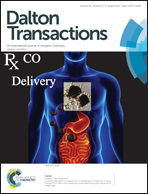Synthesis, structure and properties of [Co(NCS)2(4-(4-chlorobenzyl)pyridine)2]n, that shows slow magnetic relaxations and a metamagnetic transition†
Abstract
The reaction of Co(NCS)2 with 4-(4-chlorobenzyl)pyridine (ClBP) leads to the formation of Co(NCS)2(4-(4-chlorobenzyl)pyridine)4 (1) and [Co(NCS)2(4-(4-chlorobenzyl)pyridine)2]n (2). In the crystal structure of 1 the Co(II) cations are octahedrally coordinated by two terminal bonded thiocyanato anions and four ClBP ligands, whereas in 2 the Co(II) cations are linked into chains by pairs of μ-1,3-bridging thiocyanato anions. Magnetic measurements of 2 show an antiferromagnetic phase transition with TN = 3.9 K. A metamagnetic transition is observed at the critical magnetic field of 260 Oe. Magnetic relaxations in the zero field are consistent with single chain magnetic behavior. These results are compared with those obtained for similar compounds reported recently.
![Graphical abstract: Synthesis, structure and properties of [Co(NCS)2(4-(4-chlorobenzyl)pyridine)2]n, that shows slow magnetic relaxations and a metamagnetic transition](/en/Image/Get?imageInfo.ImageType=GA&imageInfo.ImageIdentifier.ManuscriptID=C5DT01898F&imageInfo.ImageIdentifier.Year=2015)

 Please wait while we load your content...
Please wait while we load your content...